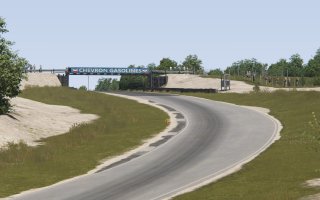While researching racing circuits around the globe, I have come across many circuits without any digital representation. And that's a shame. Whether hosting races now or in the past, circuits should be digitalised to preserve a bit of history. So, I would like to ask you, which circuit without digital representation would you like to see featured?
I have talked about this topic before. My first article on RaceDepartment, "The Importance of Modding in Sim Racing", already mentioned that digitalisation means preserving a bit of history.
And thinking about it, that is weird.
Racing game developers have one massive pool to drown their money in: licensing costs. Licensing cars, licensing circuits, and those licenses are not cheap! This begs the question of how smaller development teams could save a lot of money by not licensing those expensive modern circuits.
Solution 1: Fictional Tracks
Solution 2: Historical Tracks
There is a boatload of circuits across the globe which no longer exist. Many of those come from somewhat of a golden era of motorsports, the 50s and 60s. From those times, many circuits still exist today, largely unchanged. So tracks from the time can be brought up to date in terms of safety standards and the like.
So why does every racing circuit officially featured in a game need to be the same current version of the Nürburgring, Spa-Francorchamps or Suzuka?
Monetary gain aside, wouldn't it just be nice to find out how it could've felt like driving that one circuit that doesn't exist anymore? That is a question I keep asking myself from time to time. And furthermore, what if that circuit wasn't abandoned but driven nowadays with modern cars?
All that beauty is possible thanks to the powers of digitalisation.
What Circuit would you like to see featured that hasn't been digitalised yet?
Personally, I would like to see every track digitalised. My dream is to have a complete database for all of the world's racing circuits. But if I had to pick some special ones, I would choose
I have talked about this topic before. My first article on RaceDepartment, "The Importance of Modding in Sim Racing", already mentioned that digitalisation means preserving a bit of history.
How Developers Could Benefit from Historic Venues
However, it is not only the modders who can keep historic venues alive. The game developers themselves could take a good look at past circuits to feature in their works. At the moment, Reiza seems to be the only professional development studio somewhat focusing on historical content.And thinking about it, that is weird.
Racing game developers have one massive pool to drown their money in: licensing costs. Licensing cars, licensing circuits, and those licenses are not cheap! This begs the question of how smaller development teams could save a lot of money by not licensing those expensive modern circuits.
Solution 1: Fictional Tracks
Solution 2: Historical Tracks
There is a boatload of circuits across the globe which no longer exist. Many of those come from somewhat of a golden era of motorsports, the 50s and 60s. From those times, many circuits still exist today, largely unchanged. So tracks from the time can be brought up to date in terms of safety standards and the like.
So why does every racing circuit officially featured in a game need to be the same current version of the Nürburgring, Spa-Francorchamps or Suzuka?
How Modders Could Benefit from Historic Venues
Though, some tracks should still be up for grabs for the modders. After all, with recent announcements on how the modding systems in Rennsport and GTR Revival are supposed to work, modders could earn a pretty penny modding their hometown historical circuit.Monetary gain aside, wouldn't it just be nice to find out how it could've felt like driving that one circuit that doesn't exist anymore? That is a question I keep asking myself from time to time. And furthermore, what if that circuit wasn't abandoned but driven nowadays with modern cars?
All that beauty is possible thanks to the powers of digitalisation.
Back on Track: What Circuit Would You Like to See?
After taking that little detour to once again hope and bring some more people into modding for digitalisation, let's get back to the question at hand.What Circuit would you like to see featured that hasn't been digitalised yet?
Personally, I would like to see every track digitalised. My dream is to have a complete database for all of the world's racing circuits. But if I had to pick some special ones, I would choose
- Wachauring (the circuit I live closest to)
- Autódromo de Benguela (Angolan circuit now converted to housing)
- Evbuobanosa Motorsport Raceway (short-lived Nigerian circuit with races between 2017 and 2020, also I tried modding this one a while back, should continue on it)

